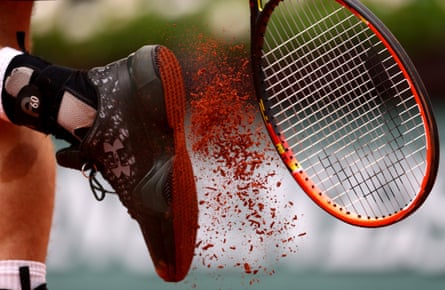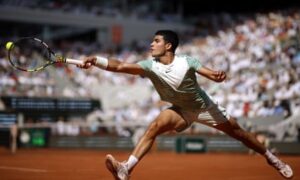When a cramping Michael Chang and his infamous underhanded serves shocked tournament favorite Ivan Lendl and the entire tennis world en route to winning the 1989 French Open, it marked the first time an American man had won at Roland Garros since Tony Trabert in 1955, an infamous streak of 34 years.
Following Chang’s sole major triumph, there was a mini-renaissance of sorts for the American men in Paris over the next decade and it appeared that the Americans’ futility on clay was a thing of the past; Jim Courier would take home back-to-back French trophies in 1991 and 1992, and Andre Agassi capped his career grand slam taking the title in 1999.
But here we are once again, mired in the midst of another slump for the Americans on the clay, as 25 years have passed since Agassi’s sole French triumph. And, from the looks of it, this streak shows no signs of abating.
Of course, American men haven’t fared well at any of the slams the last two decades, with Andy Roddick’s US Open victory in 2003 the last time an American won a major title. But Roddick also made four additional slam finals after that. And the current top ranked Americans (Taylor Fritz, Tommy Paul, Ben Shelton, Frances Tiafoe and Sebastian Korda) are at least viable threats in the non-clay majors. But on the terre battue? The brutal truth is that most would be shocked if an American man even made the quarter-finals in Paris. None of the aforementioned have made it past the week at Roland Garros.
The reasons or theories for the Americans’ epic struggles on the red dirt are myriad, depending on who you ask: Americans play mostly on hard courts as juniors and it’s too late to adjust to the clay; because they’re not used to the clay, they don’t develop the sliding skills required for nimble court coverage on the surface; American men focus too much on the one-two punch of the big serve and forehand and don’t use the drop shot enough (see: Alcaraz, Carlos); finally, perhaps it has something to do with the American ethos of impatience, where lingering is considered lazy and, therefore, they don’t have the mindset needed to construct the long points on the clay.
What’s interesting is that this clay barrenness that afflicts American men has not affected the women. Consider: American women have accounted for 15 French titles in the open era (1968 onwards), which includes arguably the greatest female clay-courter of all time, Chris Evert. Serena Williams was the last American woman to win in Paris, in 2015, and since then two other Americans, Sloane Stephens in 2018 and Coco Gauff in 2022, reached the final. And Gauff will certainly be considered one of the two leading contenders behind the increasingly clay dominant Iga Świątek when the French fortnight kicks off on Sunday.
Of the American men, it would appear that Shelton and Korda would be the two who could break through in Paris in the coming years. Ironically, both own clay-court titles, with Shelton winning in Houston a few weeks ago. (Korda’s sole ATP title was at a clay event in Romania in 2021) Shelton’s lethal serve will always give him a chance on any surface, though the clay mutes that power somewhat. He’s also expanding his arsenal of shots and he will likely develop into a serious threat on the surface. But can he beat Alcaraz or Novak Djokovic or Caspar Ruud or even the aging Nadal this year? Odds are heavily against it.

Korda, whose seemingly limitless all-court potential has been the talk of the American tennis world for several years now, has been labeled a disappointment by some, which is unfair since he has struggled with injuries. Korda has the complete game to vie for a French championship in his career. And he has the intangibles on his side as well: his father, Petr Korda, reached the French final in 1992, losing to Courier.
Granted, if an American is to stun the tennis world and do well at the French, there are some wild cards at play here. Nadal is at the very end of his career and he hasn’t been close to form, even on his beloved surface, since returning to the tour sparingly this year. Djokovic has been a huge question mark all year as he’s yet to win a title heading into Paris (he is playing the event in Geneva this week in an effort to be ready for Roland Garros). And Alcaraz, after winning Indian Wells, has been struggling with stubborn arm issues, and hasn’t played in three weeks, having competed in just one clay-court event this season (Madrid). So it’s not out of the question for Shelton or even Taylor Fritz, if they’re serving at their peak, to ride a favorable draw and make it deep into the tournament.
And while it’s been the Americans who have struggled to make inroads at the French Open in recent decades, it’s instructive to recall that for much of the open era, most of the top players – American or elsewhere – also failed to win in Paris. In fact, save for two major outliers – Bjorn Borg and Lendl – the best players all struggled: Jimmy Connors, John McEnroe, Boris Becker, Stefan Edberg and Pete Sampras could never crack the clay code. Of this group, only McEnroe and Edberg even reached the final in Paris. It was almost an unfortunate badge of honor of some sort, not winning in Paris, akin to so many of the best directors never winning an Academy Award (Orson Welles, Alfred Hitchcock, Stanley Kubrick, et al).
In fact, the French, out of all the slams, produced far more one-surface slam champions than the other majors, evidence that for many years Roland Garros was a hunting ground for the clay-court specialists who didn’t fare as well as the other major championships.
Consider the number of players in the open era who won the French but never the other Slams: Andres Gimeno, Adriano Panatta, Yannick Noah, Michael Chang, Sergie Brugera, Tomas Muster, Carlos Moya, Gustavo Kuerten, Albert Costa, Juan Carlos Ferrerro and Gaston Gaudio. Compare that number with those won won only Wimbledon (Pat Cash, Michael Stich, Richard Krajicek, Goran Ivansevic) or the US Open (Manuel Orantes, Pat Rafter, Roddick, Juan Martin del Potro, Marin Cilic, Dominic Thiem and Medvedev). There have been far more “clay-only” champions v those who did well primarily on the grass or hard courts. It wasn’t until the Big Three era of Federer, Nadal and Djokovic – an era we’re technically still living in – that all of the very best players were competitive on the dirt.
Is it out of the question that a young American can come out of nowhere and win the French Open, as Chang did 35 years ago? Yes. But then again, no one saw Chang’s miracle coming either.
Source: theguardian.com


















